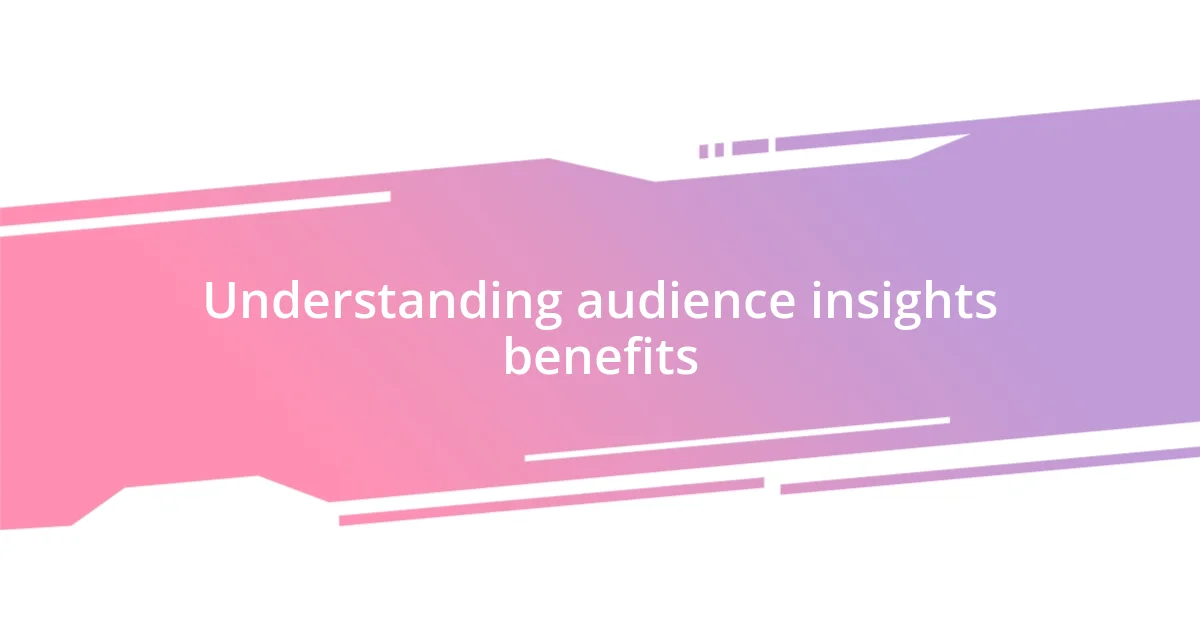Key takeaways:
- Understanding audience insights enhances content strategy, fosters loyalty, and drives business growth through informed decision-making.
- Utilizing various data-gathering methods such as surveys, social media analytics, and website analytics uncovers valuable insights that can refine marketing efforts.
- Adapting marketing strategies based on audience feedback and behavior trends, such as preferences for specific content types, leads to more meaningful engagement and community building.

Understanding audience insights benefits
Understanding audience insights is truly transformative for any content creator or marketer. When I first delved into audience profiling, I realized that I could tailor my messages to what genuinely resonates with my audience. For instance, by analyzing their preferences, I increased engagement on my social media posts significantly. It made me wonder, how much potential impact are we missing by not truly knowing our audience?
Moreover, implementing audience insights helps in creating more meaningful connections with followers. I recall a time when I pivoted my approach based on feedback I gathered from my audience’s responses, and the shift was remarkable. Seeing how a simple adjustment could foster deeper interactions left me amazed. Isn’t it powerful to think that understanding your audience can enhance loyalty and trust?
On a broader scale, leveraging audience insights can inform strategic decisions that drive business growth. I saw firsthand how a friend’s company used insights to craft a laser-focused marketing campaign, resulting in a notable revenue boost. It made me reflect on the potential opportunities layoffs in simply guessing what will work, rather than making informed decisions grounded in real audience data. Wouldn’t you agree that insights could be the key to unlocking unprecedented success?

Types of audience insights available
Understanding the different types of audience insights available is crucial for effective targeting. Personally, I’ve found that digging into these insights can uncover layers about my audience that I never knew existed. It’s like peeling back the onion; each layer reveals something that can sharpen my content strategy. Here are some key types of insights I’ve come across:
- Demographic Insights: Information such as age, gender, income, and education level helps shape the core of your audience profile.
- Psychographic Insights: This involves understanding attitudes, values, interests, and lifestyles, which adds depth to your audience’s persona.
- Behavioral Insights: Examining how audiences engage with your content, including their online activities, preferences, and purchasing behaviors.
- Geographic Insights: Knowing where your audience is located can tailor your message to be culturally relevant and timely.
- Feedback Insights: Valuable input from surveys, comments, or direct interactions with your content, giving you insight into what your audience truly thinks.
I remember a particular instance when I used behavioral insights to revamp my email marketing strategy. By observing the peak times my audience engaged with previous campaigns, I adjusted my sending schedule, and the results were astounding! It felt rewarding to see my efforts pay off in real-time, confirming that audience insights are not just data but vital tools to refine our messaging and connect on a more personal level.

Methods for gathering audience data
Gathering audience data is a foundational step in understanding who your audience is and what they value. One of my go-to methods is using surveys. I remember when I sent out a simple survey to my email list, asking for feedback on recent content. The responses not only provided statistical data but also opened a treasure trove of qualitative insights. People appreciate when you ask for their opinions. You’d be surprised at how many valuable suggestions and ideas come pouring in when you simply engage with your audience.
Social media analytics is another powerful tool I often utilize. Platforms like Facebook and Instagram offer in-depth data on audience engagement, which can reveal not just who is interacting with your content, but also how. For instance, I noticed a spike in engagement when I posted behind-the-scenes content about my work process. This revelation made me rethink my content strategy, steering me towards more authentic and relatable posts that my audience craved. Isn’t it fascinating how these analytics can guide content in real time?
Lastly, website analytics tools such as Google Analytics provide invaluable insights into audience behavior on your site. I recall a time when I delved into my site’s data and discovered that visitors were spending significant time on a particular blog post. This insight prompted me to create a sequel post, expanding on the themes explored. The result? A dramatic increase in site visits and shares. It’s moments like these that illustrate how audience data not only informs but can also inspire new ideas and topics worth exploring.
| Method | Description |
|---|---|
| Surveys | Collect direct feedback and insights from your audience. |
| Social Media Analytics | Analyze audience engagement and preferences on social platforms. |
| Website Analytics | Monitor audience behavior and preferences on your site. |

Analyzing audience behavior patterns
When I dive into analyzing audience behavior patterns, I often focus on their engagement rates with different types of content. For instance, I was once surprised to find that my audience responded more enthusiastically to short, punchy videos rather than longer articles. It made me wonder: what pulls them in? This realization empowered me to create more concise video content, which not only boosted engagement but also fostered a deeper connection with my followers.
Another fascinating aspect I’ve encountered is the cyclical nature of audience behavior. Certain topics or themes resonate strongly during specific times of the year, such as holidays or seasons. I recall launching a campaign focused on summer activities and seeing an immediate uptick in engagement. It made me appreciate how seasonal trends can serve as a compass in guiding content strategies. Have you noticed similar patterns in your audience? I believe tapping into these behavioral trends can transform our approach, directing us toward what’s most relevant and timely for our audiences.
Lastly, I’ve found that audience feedback can significantly shape future behaviors. After a workshop I hosted, I encouraged attendees to share their thoughts. One participant’s suggestion led me to incorporate Q&A sessions into my future events, which turned out to be a game-changer. The back-and-forth interaction not only promoted a sense of community but also kept attendees coming back for more. Recognizing these behavioral patterns not only enhances the content experience but also builds lasting relationships. Don’t you think understanding these dynamics can add a layer of richness to our audience connections?

Applying insights to marketing strategy
When I think about applying audience insights to my marketing strategy, one of the standout moments occurred when I experimented with personalization. After analyzing audience data, I noticed specific segments of my audience were interested in particular topics. By tailoring my email campaigns to speak directly to these interests, I saw a remarkable increase in open rates and engagement. Isn’t it empowering to see data transform into meaningful connections?
Another transformative experience was during a product launch. By leveraging insights from previous surveys, I adjusted my messaging to address common pain points expressed by my audience. This not only resonated deeply with them but also created buzz around the launch because it felt like I was speaking their language. Have you ever tailored your approach based on what your audience truly values? It’s amazing how this level of understanding can lead to a more impactful strategy.
I also found that integrating storytelling based on audience insights significantly enriched my marketing efforts. For instance, after gathering feedback on certain customer experiences, I crafted stories highlighting those narratives. This approach not only made my content more relatable but also fostered loyalty among my audience. I often ask myself, how well do I know my audience’s stories? Recognizing and weaving these narratives into my strategy truly helps in creating a holistic experience that resonates.

Measuring the impact of insights
When it comes to measuring the impact of audience insights, I find that quantitative data often tells just half the story. For example, I once launched a campaign that had stellar click-through rates, but feedback revealed that audience sentiment was lukewarm. This taught me that metrics need to align with emotions—if the audience feels disconnected, even great numbers can mask deeper issues. Have you ever experienced this disconnect in your strategy?
On another occasion, I decided to track the performance of a series of blog posts over time. I noticed that while one post initially garnered lots of views, engagement dwindled after a few weeks. This pattern made me realize the importance of continuously refreshing content and keeping it relevant to my audience’s evolving interests. Isn’t it interesting how the lifecycle of content can change based on audience feedback and preferences?
Moreover, I’ve learned that qualitative insights—like comments and direct messages—are invaluable for measuring impact. A heartfelt message from a follower expressing how much a piece of content resonated with them often holds more weight than any statistical analysis. It’s these personal connections that remind me why understanding my audience truly matters. Have you ever received feedback that transformed your perspective on your content? Those moments really create a sense of community and show the real power of meaningful insights.

Adapting to changing audience needs
Adapting to changing audience needs is like tuning a delicate instrument—small adjustments can make a huge difference in performance. I recall a time when I ran a survey and discovered that a significant portion of my audience was shifting their interests toward sustainability. Inspired by this feedback, I pivoted my content to include eco-friendly practices and products, which not only resonated with my audience but also attracted new followers who valued this commitment. How often do we miss out on these shifts by not regularly checking in with our audience?
I vividly remember adjusting my social media strategy after noticing the rise of visual content. I had been pouring hours into creating text-heavy posts, only to realize that my audience was more engaged with brief videos and infographics. This revelation was a game-changer. The moment I embraced visual storytelling, I saw my engagement metrics soar. It made me wonder—are we sometimes too stubborn to adapt and embrace what our audience is telling us?
One particularly insightful moment occurred during a marketing meet-up where I listened to others share their experiences. They spoke about the power of real-time responses to audience needs, and it struck a chord with me. After implementing a more agile approach, like responding to trending topics and audience questions in my content, I felt more connected than ever. It made me ask: are we ensuring our strategies remain fluid enough to embrace these spontaneous changes? Adapting in real-time has transformed my engagement, making me eager to keep the conversation flowing with my audience.












